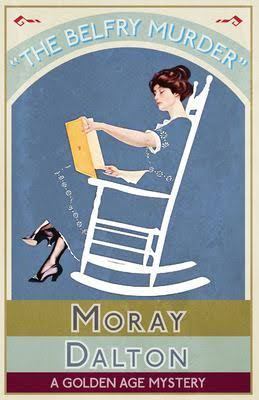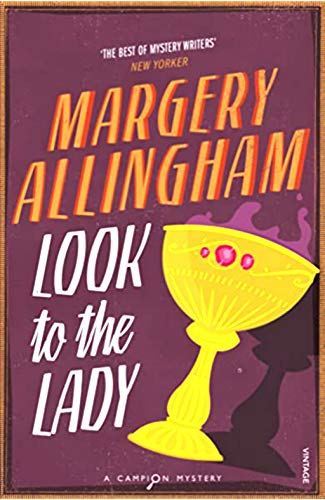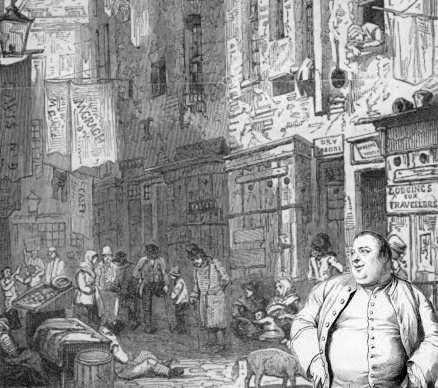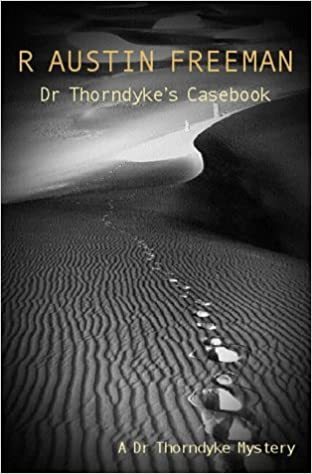Martin Fone's Blog, page 172
January 8, 2021
The Belfry Murder

The Belfry Murder – Moray Dalton
Moray Dalton, the nom de plume of Katherine Dalton Renoir, is one of those Golden Age detective fiction authors who has sadly and unwarrantedly fallen out of favour. All is not lost, though, and thanks to the efforts of the wonderful people at Dean Street Press, her works are being reintroduced to a modern audience. The Belfry Murder, the third book in her Inspector Hugh Collier series, was originally published in 1933.
This is a well-paced, entertaining, and enthralling story with many of the elements you expect from the genre. We have two gangs, one a shady group of Russians and the other a group of gullible hooray-Henrys under the control of a criminal mastermind who have diverted from their usual pursuit of peddling drugs to chasing the big one. Their target are some jewels, including the famed Eye of Nero, belonging to Countess Nadine, which were smuggled from Russia during the Bolshevik revolution by an English governess, Mary Borlase. They have remained hidden, or so it is thought, in a run-down antique shop in the backstreets of London. Suddenly, after fourteen years, their whereabouts have come to light and the two ruthless gangs are in a race to secure them, irrespective of what gets in their way.
Along the way, there is a brutal murder and the kidnapping of a young girl. As the book progresses, though, the recovery of the jewels rather subsides into the background, the Russians, the assumption being, are smarter and more efficient than their British counterparts. Instead, the focus of the book turns to the death of one of the young Hoorays, who seemingly had hung himself in the belfry, the bell tolling ominously as he went into his death throes. Ostensibly it is a clear case of suicide, but Collier is not convinced. His investigations unearth a tangled web of intrigue and deceit, which draw many of the strands of a disparate plot together.
I will not spoil your enjoyment of this excellent tale by saying too much more, rather to highlight an interesting aspect of Dalton’s style and world perspective. One of the problems with reading books, particularly those written in the 1930s, is that often the reader is confronted with attitudes and portrayals of nations, races and classes which rather jar on modern sensibilities. The reader, of course, has the choice of throwing the book down in disgust, if offended, or to take the view that, regrettable as un-PC views are, that was par for the course then. I fall into the latter category, which means that I do not condone antisemitic or racist attitudes, rather I mark the book down and, probably, would steer away from that author in future.
Two of Dalton’s principal characters, father and son Israel and Maurice Kafka, are Jewish and my heart sank as I thought 1930s, antisemitism. What was surprising and pleasing is that Dalton portrayed them with sympathy and sensitivity. In some ways they were stereotypical, and often repeated racist slurs and jibes about themselves, but as the narrative unfolded, they were among the more appealing and endearing characters in what, admittedly, was a fairly bad bunch. Even if the book had not been top notch, Dalton would have gone up in my estimation just for that.
A lovely book and well worth a read.
January 7, 2021
Gin O’ndina

Can you really conjure up the spirit of a place through a bottle of gin? The ginaissance has spawned so many gins that the geniuses in the marketing departments have to burn the midnight oil to give their product a distinctive edge, sufficient to make it stand out in the crowd. Gin O’ndina, another impressive small batch, premium aka expensive, gin to come out of Italy, this one distilled by the Milanese company, Davide Campari-Milano SpA, is said to conjure up the “glamour and carefree spirit” of the Italian Riviera in the 1960s.
To reinforce the message the logo at the front of the bottle features a young woman looking longingly into the distance, gazing at a curved bay with white sand and a large sun sinking below the horizon. Oddly, there is no glass of O’ndina in front of her and the swirling geometric design immediately beneath her makes her look like a mermaid. Perhaps she is waiting for her Romeo to deliver her drink which will make her perfect day more perfect still?
The bottle is elegant in design, a squashed heptagon in shape with a short neck leading to an artificial stopper with a deep blue cap. The glass is clear and the blue colour scheme is meant to evoke the warmth of the Ligurian Sea. The labelling at the bottom fifth of the bottle tells me that it contains “fresh basil from Liguria, citrus from southern Italy and a mix of native herbs, selected to portray an Italian coastal landscape in every sip”.
Frustratingly, this is as much information as we get about the contents, although the gin is supposed to use 19 botanicals. The variety of basil deployed is Grande Verde di Genova which, I’m told, is characterised by its very bright green colour and especially refreshing sweetness. The juniper is sourced from the Apennine Mountains, the orris root from Tuscany and the liquorice from Calabria while the foothills of Piemonte provide sage, marjoram, thyme and fennel. It does annoy me when you cannot get a full list of the runners and riders.
What makes me wary of some European gins is their use of a wine base spirit which, in my experience, makes for an acerbic starting point which very few combinations of botanicals can ever successfully eradicate. However, I cannot detect its presence here, a distinct plus point. The spirit and botanicals are distilled in fresh, clear Alpine spring water and bottled with a very impressive ABV of 45%. This is not a gin to while away the sunny hours with; it has a kick.
On opening the bottle my senses were assaulted by a heady mix of pepper, herbs and citrus with a welcome hit of juniper. In the glass it is crystal clear and the juniper, forward and bright, immediately makes its presence known before allowing the herbs a place at the table and the citric notes to breathe expansively. There is a hint of liquorice which lingers into the aftertaste which together with peppery spices and another blast of juniper leaves a lingering and satisfying taste.
Overall, I found it a well-balanced spirit with enough variety in the taste sensations to interest me and make me want to take another sip. Considering its strength, I did not find it as spicy as I had anticipated and the juniper maintained a prominent position throughout, always a plus in my book. If you are looking for a classy, elegant gin, this will not disappoint you. Did it remind me of the Italian Riviera? Not really, but that is marketeers for you.
Until the next time, cheers!
January 6, 2021
Look To The Lady

Look to the Lady – Margery Allingham
Published in Britain in 1931, it is the third of Allingham’s novels to feature her leading man, Albert Campion, and his faithful valet and ruffian, the wonderfully named, Magersfontein Lugg. It was published in the States under the more prosaic title of The Gyrth Chalice Mystery. It is a wonderfully engaging, slightly ridiculous tale with a delightful cast of memorable characters and dastardly villains. Although there is a murder along the way, which Campion solves, and most of the action takes place within that most reliable of detective tropes, a country estate, to my mind it is more of a thriller than a murder mystery, and all the better for it.
Allingham seems obsessed with international conspiracies and, in this book, we meet an international gang of thieves whose aim is to steal the rarest of art treasures and sell them to specialist private collectors. The Gyrth family are the custodians of a chalice, reputedly over a thousand years old, and, naturally, it is on the gang’s radar screen.
The heir to the Gyrth estate, Val, is down on his luck when we first meet him, living as a tramp and about to be kidnapped by the ruffians, presumably as a hostage to be bartered for the treasure. Campion steps in and foils the kidnap. It is his mission, his employers are equally as shady as the art cabal, is to foil the theft. Under the terms of engagement, the thieves will only abandon their attempts if their employer dies. So, as well as thwarting the thieves, Campion will have to murder the person who wants to own the chalice.
The book is melodramatic in a tongue-in-cheek sort of way. Amongst the cast list we find a band of sinister gypsies who have encamped near the Gyrth country estate, an unpleasant aunt of Val’s who is promptly killed, an American professor and his attractive daughter, an ancient tower with a hidden room in it, things that go bump in the night with a penchant for driving people to distraction, and a killer racehorse.
Campion, who is drawn as a sort of Lord Peter Wimsey character with a bit more physicality about him is, naturally, up to the challenge. For me, the character of the story is Lugg. He provides moments of comedy, is an ex-con and gives Campion with added muscle but is not averse to taking umbrage with his employer.
Perhaps with a knowing nod to Holmes, Campion is persuaded to explain his detective methods. “The process of elimination, said he oracularly…combined with a modicum of common sense, will always assist us to arrive at the correct conclusion with the maximum of possible accuracy and the minimum of hard labour. Which being translated means: I guessed it”. The clues are all there for the attentive reader to follow, but Campion is no Thorndyke. He seems to make the right choices and pops up at the opportune moment.
Allingham’s style is easy on the reader, her characterisations well drawn, and she knows how to ratchet up the tension when necessary. It makes for a wonderful book and a story to immerse yourself in if you fancy a bit of pure escapism laced with a modicum of lunacy.
January 4, 2021
The Lost Game Of Bullet Pudding

Despite its name, an abbreviation of the Swahili word kujenga, meaning to build, the fiendish game of Jenga is a British invention. The brainchild of Leslie Scott, it was first marketed at the London Toy Fair in January 1983. The starting point is to build a tower from the 54 wooden blocks that make a set and then each player takes it in turn to remove a block and then place it on top of the structure which becomes increasingly unstable. It takes a steady hand and some luck not to send the structure crashing down with a loud thud accompanied by the gleeful cheers of your fellow players. I have always liked to think that this visual and practical demonstration of the stability of structures is part of the (ahem) foundation course for would-be architects.
Games involving the come-uppance of a clumsy player have a long legacy. A game that proved a bit of a hit in the Regency period was Bullet Pudding, a mix of Jenga and the children’s game, Pie Face, and apple bobbing. Fanny Austen Knight, Jane Austen’s niece, was a fan of the game, mentioning it at least twice in her surviving correspondence. In 1806, she wrote “different amusements every evening! We had Bullet Pudding, then Snap-Dragon” – we will look at that curious game another time – “and…we danced or played cards”. Sounds fun.
Not everyone knew of or was enamoured by Bullet Pudding and, fortunately, one of Fanny’s correspondents, a Miss Dorothy Chapman, was blissfully unaware of the delights of the game. This prompted the incredulous Fanny to give her a detailed description of the fun and japes they had at Godmersham Park in a letter from 1808.
I can do no better than to quote it in full. The lack of punctuation and the breathlessness in the description is Fanny’s; “I was surprised that you did not know what a Bullet Pudding is but as you don’t I will endeavour to describe it as follows: You must have a large pewter dish filled with flour which you must pile up into a sort of pudding with a peek at top. You must then lay a bullet at top and everybody cuts a slice of it, and the person that is cutting it when it falls must poke about with their noses and chins till they find it and then take it out with their mouths of which makes them strange figures all covered with flour but the worst is that you must not laugh for fear of the flour getting up your nose and mouth and choking you: You must not use your hands in taking the Bullet out”.
You can imagine the reaction of the rest of the players as the unfortunate loser emerged with their faces covered in flour. If you did not have a bullet, a coin of the realm would do just as well. The servants must have groaned inwardly when they heard that their betters were proposing a game, thinking of the mess that would be left for them to clear up.
As well as the mess and seeing one of your part undergo a mild form of humiliation, one of the attractions of the game was that it allowed both sexes to mix in fairly intimate circumstances and such opportunities were to be snatched at in their otherwise closely chaperoned world. Sadly, the delights of the game soon waned but its legacy is still with us to this day.
The illustration at the top of this post was by Francis Hayman and shows the moment when the bullet toppled from the top of the pyramid of flour to the delight of all bar one.
December 31, 2020
Cantering Through Cant (14)

Appearing before the magistrate was an occupational hazard for many of those from whom Francis Grose garnered the words that make up his A Classical Dictionary of the Vulgar Tongue (1781). The judge was known as a fortune teller because he “told every prisoner his fortune, lot, or doom”. To go before the fortune teller was to stand trial at the assizes. Variants were to go before the lambskin men or a conjurer.
A visit in front of the judge may result in a Friday face, a term defined as “a dismal countenance”, so called because as well as being the traditional day of abstinence, after the restoration of the monarchy, King Charles II issued a proclamation “prohibiting all publicans from dressing any suppers on a Friday”.
A freeholder was a man “whose wife accompanies him to the ale-house” where he may have felt obliged to buy her a French cream, the slang for brandy, so called, says Grose, because old dowagers and tabbies used to put it in their tea. If the bill for his fare took him by surprise, he may be tempted to take French leave, defined as “to go off without taking leave of the company; a saying frequently applied to persons who have run away from their creditors”.
A difficult day may have been made worse if he found himself Frenchified, “infected with the venereal disease”. Safer, perhaps, to be a fumbler, “an old or impotent man”.
December 30, 2020
Enter A Murderer

Enter A Murderer – Ngaio Marsh
Published in 1935 this is Marsh’s second detective novel and features Detective Inspector Alleyn and his well-connected, journalist sidekick, Nigel Bathgate. The book opens with an unpleasant argument between the theatrical impresario, Joseph Saint, and his nephew and lead actor, Arthur Soubonadier. Soubonadier then has a row with his love interest and leading lady, Surbonadier. We quickly get an insight into his character and it is no surprise that he is killed. There are several in the cast with motive enough to want to put an end to him.
It is the manner of Soubonadier’s ending that makes the story. In front of an audience at a performance of the play, The Rat and the Beaver, including Alleyn and Bathgate, he is shot dead, the dummy bullets in the gun seemingly replaced with live ones. A blackout at the start of the final act gave the murderer the opportunity to effect the switch and carry out the deed. Who did it?
Marsh was an accomplished theatre director, her speciality was Shakespearean drama, and she draws on her wealth of knowledge of the theatre to create the atmosphere – you can almost smell the greasepaint – and takes delight in detailing the foibles, characteristics and traits of the acting profession, their phobias, neuroses and petty jealousies. That is fine and adds to the colour and authentic feel of the book, but, frankly, the crime set up was cliched even for the time it was written.
I am struggling to get into Ngaio Marsh. Her early works seem to me as though she has just taken delivery of a new car and is slowly trying out the gears, timidly depressing the accelerator to see how fast and far it will go. One of my problems with the book is the role of Bathgate. He is like a puppy dog, almost always at Alleyn’s side, a role that is barely believable in a police investigation, adding barely anything to the story other than being a sort of everyman who is struggling to make sense of the clues. Alleyn’s paid sidemen, Messrs Fox and the fingerprint man, Bailey, barely get a look in, even though they have the professional skills and acumen to make a significant contribution to the investigation. Alleyn also gets emotionally entangled in the case, which is very much a 1930s thing. There is too much cliché for my taste.
If you are wanting to be pedantic, the story is not very well plotted, with loose ends, particularly in respect of the blackmail. When it rears its head, it seems to be a big deal and will play a key part in the motivation for the murder but, at the end, it just seems to be left hanging in the air. There are red herrings galore and when the culprit is finally unmasked, the solution is neat enough, but I felt had it been in more experienced hands, it would have been a much better book.
On the plus side, Marsh keeps the suspense going right up to the last minute, the culprit revealed just before the end, in almost, but not quite classic last page style. Her characterisation is good, and her writing is crisp, clear and she is capable of turning out some memorable sentences and passages. I haven’t seen anything in her early works that suggest she will rival the major female crime writers, as she eventually does, but I will continue to read the series with interest.
December 28, 2020
My Trumpeter Is Dead

It was an honour and delight to have three of my articles featured in Country Life magazine’s top ten blogs and columns of 2020. To see them, follow the link below:
Country Life’s top 10 blogs and columns of 2020, from wise owls to the invention of toilet paper
And for the origin of the curious title to this post, go to
https://windowthroughtime.wordpress.com/2020/09/18/what-is-the-origin-of-300/
December 24, 2020
Christmas Crackers (8)

To get you into the festive spirit, or not, here are some one-liners bad enough to grace a Christmas cracker:
What do you get if you cross Santa with a detective? Santa Clues!
What goes Ho Ho Whoosh, Ho Ho Whoosh? Santa going through a revolving door!
What is Santa’s favourite place to deliver presents? Idaho-ho-ho!
What did the sea Say to Santa? Nothing! It just waved!
What does Santa do with fat elves? He sends them to an Elf Farm!
What do you get if you cross Santa with a duck? A Christmas Quacker!
Who delivers presents to baby sharks at Christmas? Santa Jaws!
What’s a child’s favourite king at Christmas? A stocking!
What do you call a dog who works for Santa? Sant a Paws!
Why couldn’t the skeleton go to the Christmas Party? Because he had no body to go with!
What do you get if you cross a bell with a skunk? Jingle Smells!
Why is everyone so thirsty at the north pole? No well, no well!
What do you call a three legged donkey? A wonkey!
Why are pirates great? They just aaaaaaarrrrr!
What did Santa do when he went speed dating? He pulled a cracker
How is Drake like an elf? He spends all his time wrapping
What is the Grinch’s least favourite band? The Who!
Why is it getting harder to buy Advent calendars? Because their days are numbered!
What do you get if Santa forgets to wear his undercrackers? St Nickerless
Festive greetings to everyone.
December 23, 2020
Dr Thorndyke’s Casebook

Dr Thorndyke’s Casebook – R Austin Freeman
Sherlock Holmes, Lord Peter Wimsey, Hercule Poirot, Miss Marple…the roll call of fictional detectives is impressive but missing, at least these days, from the board of honour is Dr John Thorndyke, R Austin Freeman’s principal creation. In his day he was popular with readers and there were even some that thought he rivalled Holmes rather than simply owing his existence to Freeman’s desire to emulate Conan Doyle. Part of the problem is that Doyle is the better writer, more impressionistic and more fun to read, whereas Freeman, a medic himself, is more concerned with the logic and science behind the crimes and the conclusions that Thorndyke draws, a preoccupation which often means that his stories are duller in comparison and sometimes hard-going.
As a pure detective, though, and to some this may be a contentious point, Thorndyke is the superior, his methodology rooted in a deep understanding of science and a careful consideration and dissection of the facts that he unearths. Holmes has a flightier approach, using intuition and what he calls inductive reasoning. He sometimes gets his facts wrong and has to resort to advertising to make headway, something Thorndyke rarely, if ever, has to resort to. Devoid of eccentricities and dubious habits, Thorndyke’s sole attraction is his stone-cold logic. He is a colder fish and if you had a choice between a story involving Holmes or Thorndyke, for entertainment and the quality of the writing, most would plump for Holmes.
We ignore Thorndyke at our peril, though, as the stories, as examples of the detective’s methodology, are worth reading today, if only to recall that in the days without DNA testing a knowledge of what our politicians would call “the science” could take you a long way. Published in 1923 Dr Thorndyke’s Casebook is a collection of seven short stories, narrated to us by Thorndyke’s bagman, Jervis. Rather like Watson, Jervis, although a medic, is there to represent the everyman whose initial bafflement and then wonder as his detective friend unravels the mystery are designed to enhance the reader’s respect for the maestro.
Thorndyke, a lecturer in medical jurisprudence, has a consultative practice and members of the public are happy to engage him, rather like Holmes, either in place of the police, or in conjunction with the police, to crack a seemingly impenetrable problem. Sometimes he is called in by the police to add his considerable intellectual heft to the effort.
Three of the cases involve murder. My favourite was The Funeral Pyre where a body in a hayrick is identified by its false teeth and dental patterns on clay pipes go some way to unmasking the culprit. The Case of the White Footprints, the opening story, relies upon the unmasking of a murderer who lacks any little toes. Thorndyke, once he realises that this infirmity is a symptom of a rare disease, ainhum, is able to finger the culprit. The weakest of the trio of murders is The New Jersey Sphinx where the murderer, who has a thyroid problem, rushes around trying to incriminate and impersonate others.
The other four involve theft. The best of the quartet and the best known, The Blue Scarab, involves the loss of a jewel which holds the key to a buried treasure. The theft of a will features in The Touchstone, a necklace in A Fisher of Men and the title of The Stolen Ingots is self-explanatory. Thorndyke’s knowledge of the specific gravity of metals helps him solve the mystery.
If you haven’t tried Freeman, his short stories are a more palatable, digestible entrée to his craft than his novels.
December 22, 2020
Christmas Crackers (7)

To get you into the festive spirit, or not, here are some one-liners bad enough to grace a Christmas cracker:
What type of key do you need for a Nativity play? A don-key!
What happened to the turkey at Christmas? It got gobbled!
Why did the turkey join the band? Because it had the drumsticks!
What do you get when you cross a snowman with a vampire? Frostbite!
What do snowmen wear on their heads? Ice caps!
How do snowmen get around? They ride an icicle
What do snowmen eat for lunch? Iceburgers!
When is a boat just like snow? When it’s adrift!
What do you call Father Christmas on the beach? Sandy Claus!
What do you call a cat in the desert? Sandy Claws!
Who delivers presents to cats? Santa Paws!
Why did the turkey cross the road? Because it was the chicken’s day off!
What do snowmen eat for lunch? Iceburgers!
What says Oh Oh Oh? Santa walking backwards!
What do elves learn at school? The Elfabet!
Why can’t Christmas trees knit? Because they always drop their needles!
What’s green, covered in tinsel and goes ribbet ribbet? Mistle-toad!
What’s yellow and dangerous? Shark-infested custard!
Why is it so difficult to train dogs to dance? They have two left feet!
What wobbles and flies? A Jelly-copter!
What goes ha ha ha clonk? A man laughing his head off!
Why did the man get the sack from the orange juice factory? Because he couldn’t concentrate!
How does Darth Vader enjoy his Christmas Turkey? On the dark side!
Who’s Rudolph’s favourite pop star? Beyon-sleigh!
What did the stamp say to the letter? Stick with me and we’ll go places!



